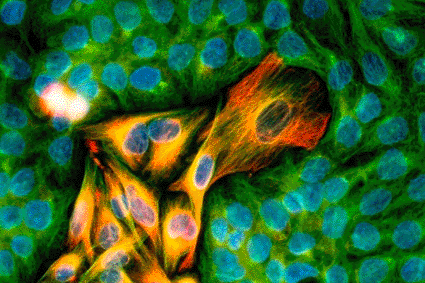Development of Drug Resistance in Melanoma Due to Kinase Action
By LabMedica International staff writers
Posted on 08 Dec 2010
Experimental chemotherapy based on reversing the effects of the B-RAF(V600E) mutation has shown initial promise in treating several types of human cancers, but this approach has been plagued by rapid development of resistance to the drugs.Posted on 08 Dec 2010
More than 30 mutations of the B-RAF gene associated with human cancers have been identified. The frequency of B-RAF mutations varies widely in human cancers from more than 80% in melanomas and nevi, to as little as 0% - 18% in other tumors, such as 1% - 3% in lung cancers and 5% in colorectal cancer. In 90% of the cases, a glutamic acid (Glu) for valine (Val) substitution at residue 599(now referred to as V600E) in the activation segment has been found. This mutation has been widely observed in papillary thyroid carcinoma, colorectal cancer, and melanomas.

Image: Immunofluorescent Light Micrograph of melanoma cancer cells invading the skin epithelium, seen in a culture preparation (photo courtesy Nancy Kedersha / Immunogen).
Early clinical tests of a candidate drug aimed at the B-RAF(V600E) mutation revealed impressive results in patients whose cancers had resisted all currently available treatments. Unfortunately, those effects proved short-lived, as the tumors invariably returned a few months later, able to withstand the same drug to which they first succumbed.
In the current study investigators at Harvard University (Cambridge, MA, USA) and the Massachusetts Institute of Technology (Cambridge, USA) sought to discover the molecular basis for the development of resistance to B-RAF(600E) inhibitors. To this end, they developed a high throughput screening method to examine the role of the nearly 600 different kinases (enzymes that catalyze the transfer of a phosphate group from ATP to various receptor molecules) that are found in human cells.
They reported in the November 24, 2010, online edition of the journal Nature that development of resistance to the B-RAF inhibitor in melanoma cells growing in tissue culture was driven by an enzyme known as COT or mitogen-activated protein kinase kinase kinase 8 (MAP3K8). COT expression was associated with de novo resistance in B-RAF(V600E) cultured cell lines and acquired resistance in melanoma cells and tissue obtained from relapsing patients following treatment with B-RAF inhibitors.
"In melanoma as well as several other cancers, there is a critical need to understand resistance mechanisms, which will enable us to be smarter up front in designing drugs that can yield more lasting clinical responses,” said senior author Dr. Levi Garraway, assistant professor of medical oncology at Harvard University. "Our work provides an unbiased method for approaching this problem not only for melanoma, but for any tumor type. We have no doubt that other resistance mechanisms are also going to be important in B-RAF mutant melanoma, but by taking a systematic approach, we should be able to find them.”
Related Links:
Harvard University
Massachusetts Institute of Technology













